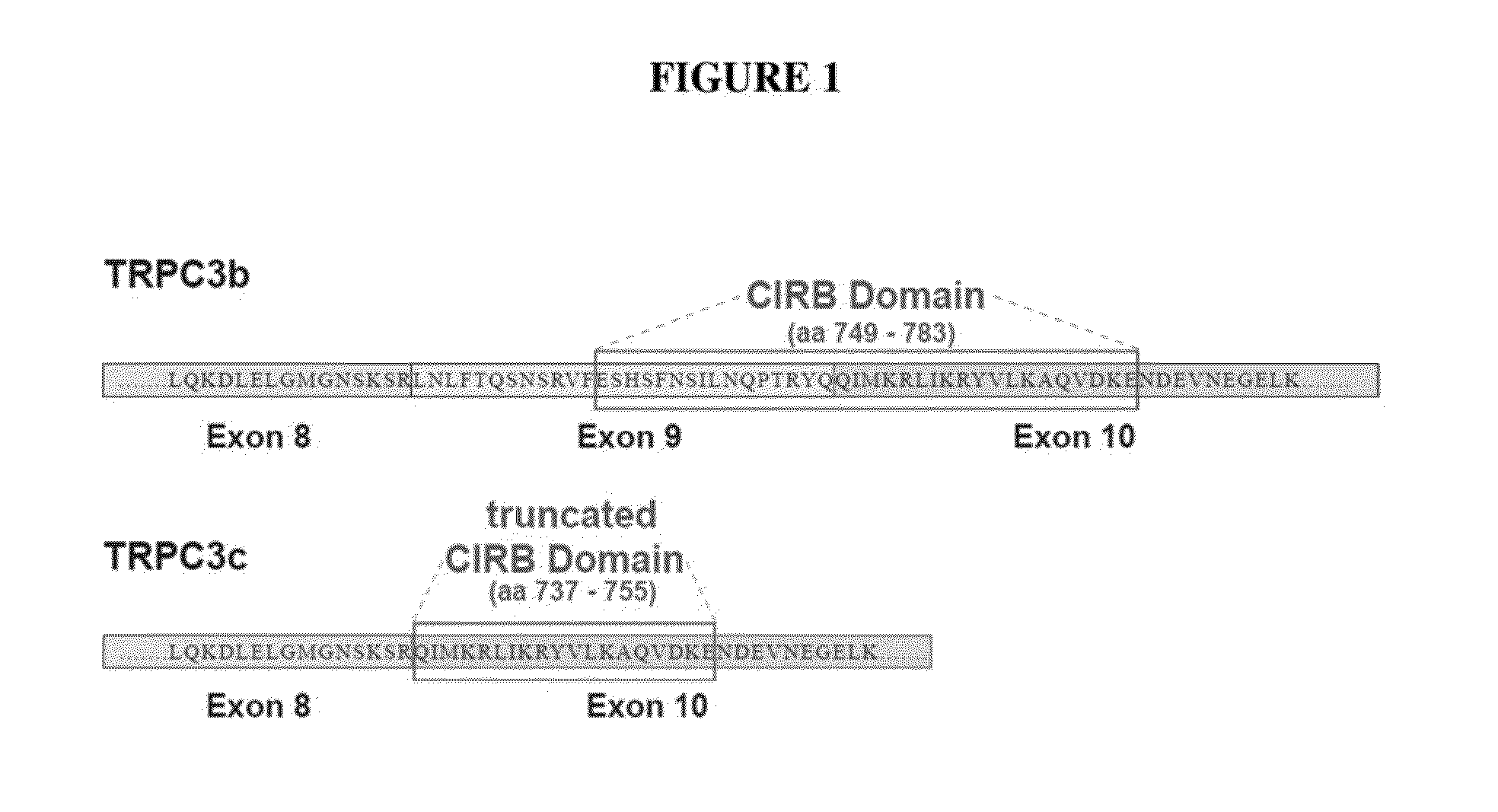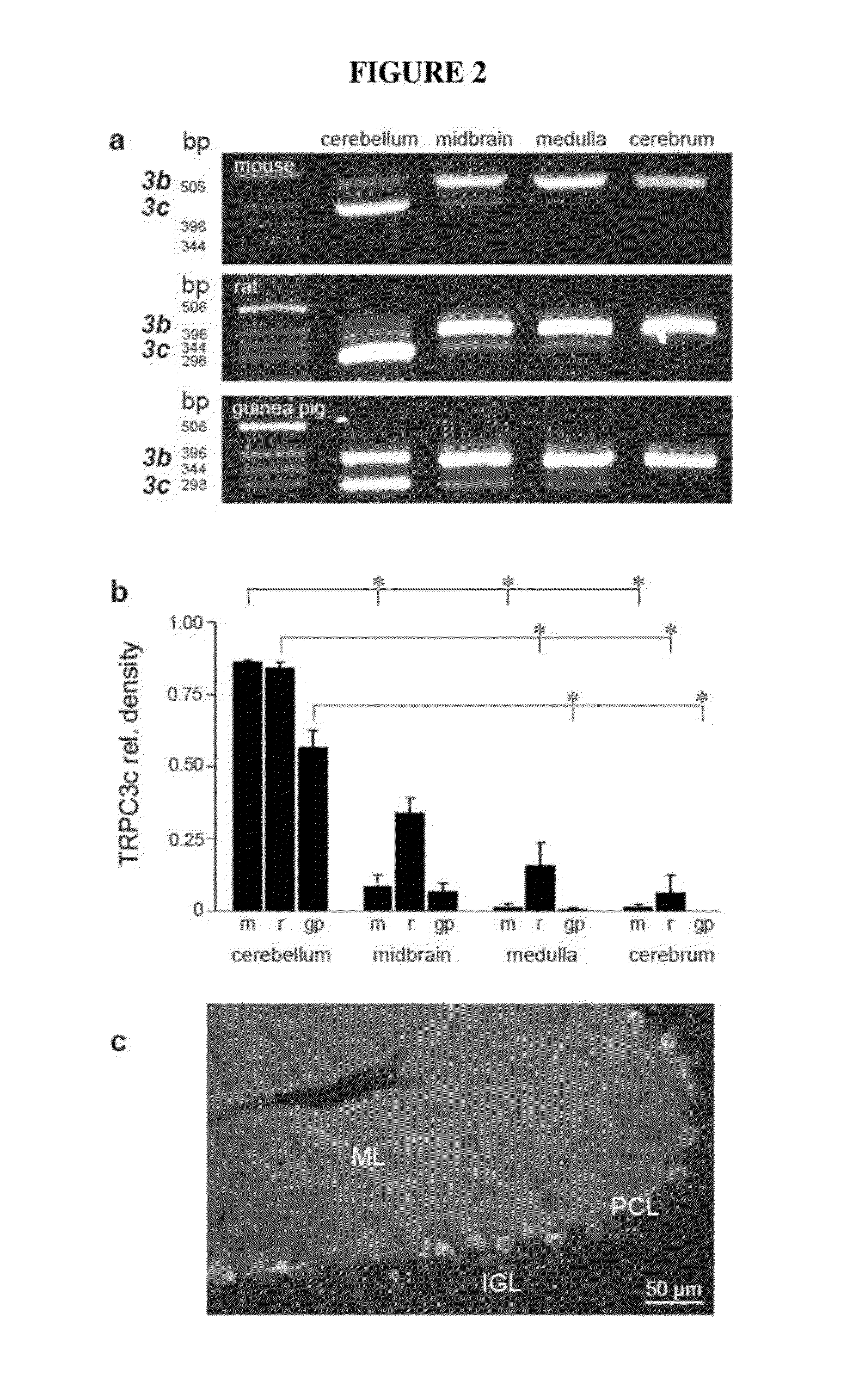Methods for inhibiting neuron apoptosis and necrosis
a neuron and necrosis technology, applied in the direction of drug compositions, peptide/protein ingredients, metabolic disorders, etc., can solve the problems of unsuccessful clinical efficacy, and restoring perfusion to the brain only partially attenuating on-going tissue damage, etc., to inhibit apoptosis or necrosis of neurons
- Summary
- Abstract
- Description
- Claims
- Application Information
AI Technical Summary
Benefits of technology
Problems solved by technology
Method used
Image
Examples
example 1
Characterization of TRPC3 and TRPC3 Expression in Brain Tissue
[0084]To characterize TRPC3 gene transcription in brain tissue, in particular the relative expression of the full length TRPC3 isoform (TRPC3b) and the TRPC3 isoform that lacks exon 9 (TRPC3c), reverse transcription and PCR amplification was performed from RNA extracted from mouse, rat and guinea pig brain tissues (cerebellum, midbrain, medulla and cerebrum). For mouse (C57BL / 6J strain) and rat (wistar) brain tissues, the total RNA was extracted using Trizol (Invitrogen, U.S.A.) according to the manufacturer's instruction. For guinea pig tissues, total RNA was extracted using Purelink total RNA isolation kit (Invitrogen, U.S.A.). The number of animals for each brain region in these experiments were as follows: mouse: n=9 cerebellum, n=5 mid-brain, medulla, n=4 cerebrum; rat n=6 cerebellum, mid-brain, medulla, n=5 cerebrum.
[0085]The RNA was then reverse transcribed using Superscript III Reverse Transcription System (Invitr...
example 2
Expression of Recombinant Mouse TRPC3b and TRPC3c Channels in HEK293 Cells
[0096]The expression of recombinant TRPC3b and TRPC3c channels in stably-transfected human embryonic kidney (HEK) 293 cells was assessed by Western blotting and microscopy.
[0097]Full length mouse TRPC3 transcripts were obtained by PCR using similar thermal cycling parameters as those described above. Full length TRPC3b and TRPC3c transcripts were detected by RT-PCR from cerebrum and cerebellum of mouse, respectively, using 5′ sense and 3′ antisense primers that targeted the regions of the start and stop codons. The forward primer had a sequences of 5′-ACAGAATTCCTGCGGGGATGCGTGACA-3′ (SEQ ID NO:19) and the reverse primer had a sequence of 5′-AGCGGATCCCCTCACTCACATCTCAGCA-3′ (SEQ ID NO:20. The restriction sites for EcoRI and BamHl were incorporated into the 5′ end of the forward and reverse primers, respectively, to facilitate cloning into the pIRES-DsRed2 mammalian expression vector (Clontech, U.S.A.). All PCR re...
example 3
Membrane Conductance of TRPC3c
[0107]The membrane conductance of the TRPC3 isoforms was assessed using whole cell electrophysiology and single cell channel electrophysiology assays.
[0108]For whole cell patch clamp recordings, HEK293 cells stably expressing recombinant TRPC3 ion channels were grown to 85-95% confluence on a coverslip coated with poly-D-lysine and collagen (both from Sigma-Aldrich, U.S.A.). Recording pipettes were made from borosilicate glass (GC120TF-10, Harvard Apparatus, U.K.). The pipette resistance was at 3-6 MΩ (PC-10, Narishige, Japan). The internal solution had the composition:130 mM CsCl, 2 mM MgCl2, 10 mM EGTA, 0.3 mM ATP, 0.03 mM GTP, pH at 7.3 adjusted with CsOH. Cells on the coverslip were placed in a microchamber on an inverted microscope (Leica DMIL, Germany) and superfused with HEPES-buffered physiological salt solution (HPSS) containing 120 mM NaCl, 5.4 mM KCl, 2 mM CaCl2, 1.13 mM MgCl2, 10 mM glucose, 20 mM HEPES (pH 7.4) a...
PUM
| Property | Measurement | Unit |
|---|---|---|
| pressure | aaaaa | aaaaa |
| conductances | aaaaa | aaaaa |
| time | aaaaa | aaaaa |
Abstract
Description
Claims
Application Information
 Login to View More
Login to View More - R&D
- Intellectual Property
- Life Sciences
- Materials
- Tech Scout
- Unparalleled Data Quality
- Higher Quality Content
- 60% Fewer Hallucinations
Browse by: Latest US Patents, China's latest patents, Technical Efficacy Thesaurus, Application Domain, Technology Topic, Popular Technical Reports.
© 2025 PatSnap. All rights reserved.Legal|Privacy policy|Modern Slavery Act Transparency Statement|Sitemap|About US| Contact US: help@patsnap.com



